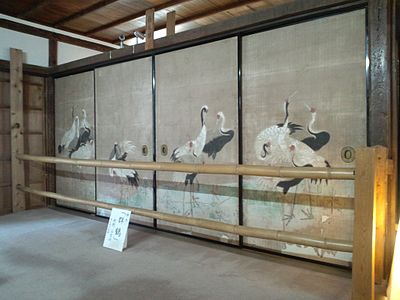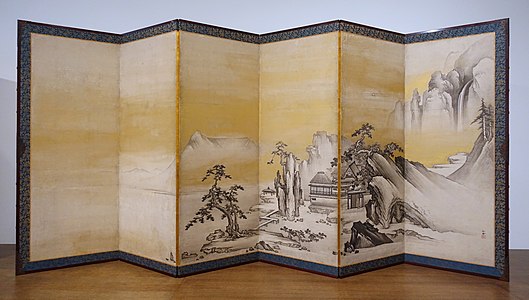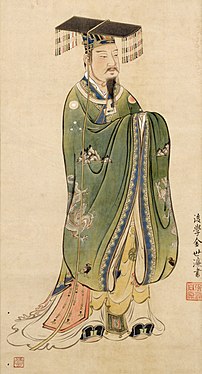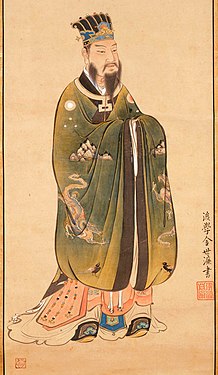Kanō Sansetsu
Appearance


Kanō Sansetsu (狩野 山雪, 1589–1651) was a Japanese painter also known as Kanō Heishiro. He was born in Hizen Province, Kyūshū, and died in Kyoto.[1]
Biography
[edit]Sansetsu was apprenticed to Kanō Sanraku, married his daughter, and was adopted by him after the death of Sanraku's eldest son.[1][2] Later, he became the leader of the Kanō school.[2] He was the father of Kanō Einō.
Works
[edit]- Dragon in the clouds, hanging scroll, ink on paper.[3]
- Huang Chuping, hanging scroll, ink on paper.[3]
- Laozi, one of a pair of six-panel folding screens, ink on paper.[3]
- Mount Fuji, hanging scroll, ink and gold on paper.[3]
- The old plum ca. 1645, four sliding door panels (fusuma), ink, color, gold leaf on paper.[4]
- Seabirds on a winter coast, screen, color, India ink, and gold on paper. collection hosotsugi, Kyoto.[2]
- The ten snow incidents, one of a pair of six-panel folding screens, ink and light color on paper.[3]
- Transcendent, hanging scroll, ink on paper.[3]
- Two chickens on thatched roof, hanging scroll, ink and light color on paper.[3]
- Xiwangmu (Seiobo), the Queen Mother of the West and Mu Wang (Bokuo), one of a pair of six-panel folding screens, ink on paper.[3]
Gallery
[edit]-
Frolicking Birds in Plum and Willow Trees, painted on four sliding doors, originally for a room at Myōshin-ji temple in Kyoto. 1631. Important Cultural Property.
-
The Old Plum, painted on four sliding doors, originally for a room at Myōshin-ji temple in Kyoto. 1646.
-
Tiger Drinking from a Raging River. Circa 1640.
-
Bridled Horse, painted on a wooden ema tablet. 1632.
-
Winter Landscape. 1615–1651.
-
Cranes on sliding doors at Yoshimizu Shrine
-
Scene from the poem Chang Hen Ge by Bai Juyi (772–846).
-
Owl on the Pine and Chicken on the Bamboo, owl section. Early 1600s.
- Folding screens
-
Waterfowl of the Winter Beach. Folding screen, left panel. 1629. Important Cultural Property
-
Waterfowl of the Winter Beach. Folding screen, right panel. 1629. Important Cultural Property
-
Wang Ziyou Visiting Dai Andao, ink painting on a folding screen. Mid 1600s.
-
A Monk Claps His Hands, ink painting on a folding screen. Mid 1600s.
- Chinese figure portraits
-
Kongzi. 1632.
-
Mengzi. 1632.
-
Yanzi. 1632.
-
Emperor Yao. 1632.
-
King Wen of Zhou. 1632.
-
The Duke of Zhou. 1632.
References
[edit]- ^ a b "Kano Sansetsu". The concise Grove dictionary of art. Oxford University Press. 2002. Retrieved 2007-11-18.
- ^ a b c Hetl-Kuntze, H. (1969). Hans L. C. Jaffé (ed.). Far Eastern Art. The Dolphin history of painting. Translated by German Erich Wolf. Thames and Hudson. p. 119.
- ^ a b c d e f g h "MFABoston". Museum of Fine Arts, Boston. Retrieved 2007-11-18.[permanent dead link]
- ^ "Attributed to Kano Sansetsu: The Old Plum (1975.268.48)". In Timeline of Art History. New York: The Metropolitan Museum of Art, 2000–. October 2006. Retrieved 2007-11-18.
External links
[edit]- Bridge of dreams: the Mary Griggs Burke collection of Japanese art, a catalog from The Metropolitan Museum of Art Libraries (fully available online as PDF), which contains material on this artist (see index)
- The Old Plum, Metropolitan Museum of Art
Wikimedia Commons has media related to Kanō Sansetsu.



















